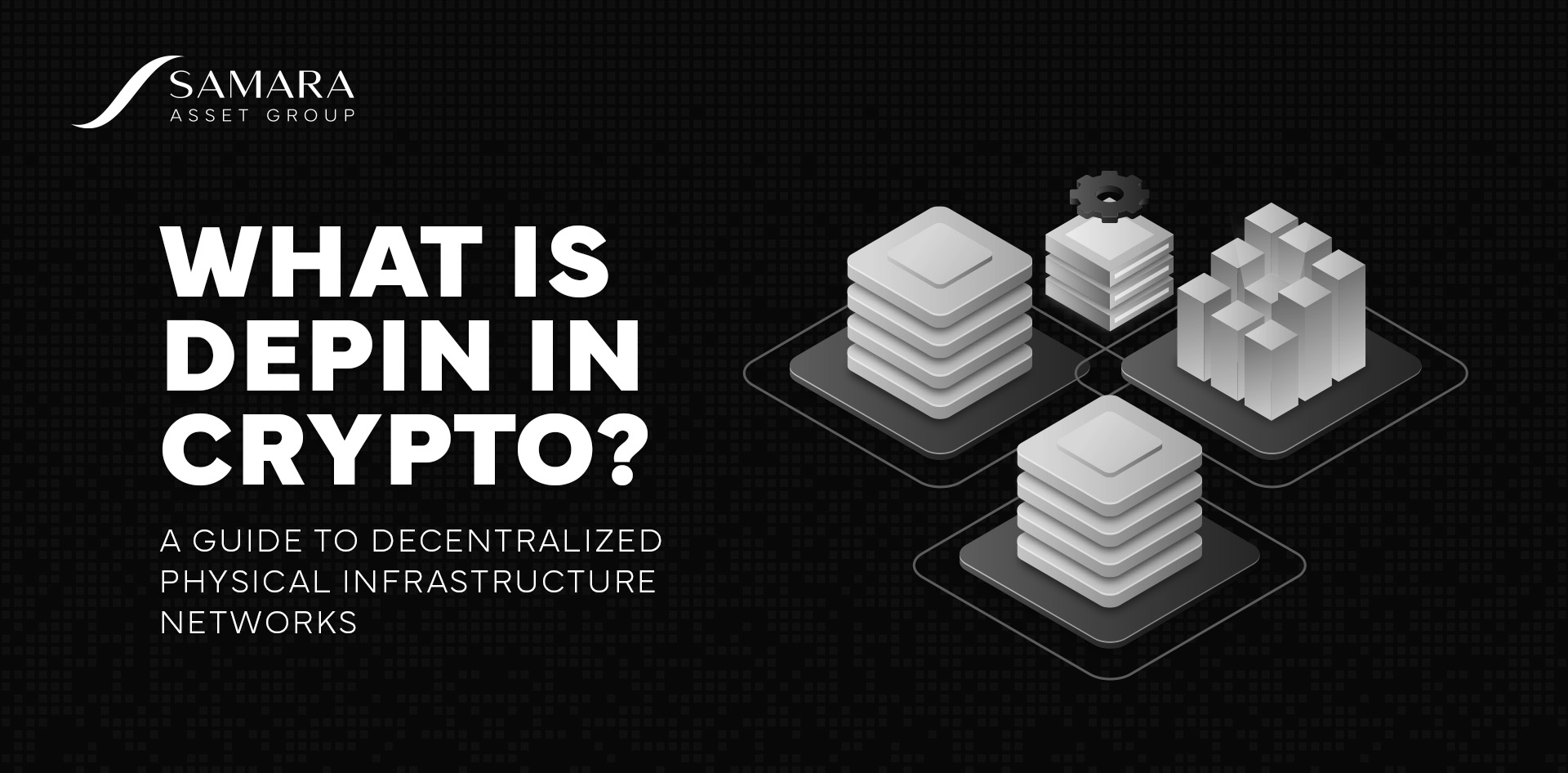Bitcoin
Bitcoin CPI
Venture Portfolio
Funds
Market Insights
Indicators
About
Contact

July 17, 2024





Blockchain technology has been taking steps into the physical world with the emergence of Decentralized Physical Infrastructure Networks (DePINs), which provide an exciting new approach to operating physical infrastructure using blockchain and token incentives.
Read this guide to learn what DePINs are and how they work.
Decentralized Physical Infrastructure Networks (DePINs) are networks that build and maintain physical infrastructure using blockchain architecture and token rewards.
DePINs are peer-to-peer (P2P) networks where people provide physical infrastructure, such as data storage, energy grids, sensors, and wireless connectivity, to build real-world networks offering goods or services.
Building and managing physical infrastructure networks, such as cloud computing, energy grids, water, and waste management systems, is challenging and expensive. Such large-scale projects require significant capital and logistics and have traditionally been undertaken by well-established firms or governments.
As a result, centralized organizations often control the market, impacting customer choice and the price of various services. This control usually results in less competition and innovation, which affects the overall quality of a customer’s experience.
However, using Decentralized Physical Infrastructure Networks, such services and systems can be built and managed decentralized, thanks to blockchain technology. DePINs can leverage blockchain to enhance efficiency, security, and transparency in physical networks, such as supply chain operations and renewable energy grids.
DePINs rely on blockchain architecture, token incentives, physical network infrastructure, and off-chain computing.
These four components are the key contributors to a DePIN protocol. Together, they enable individuals to maintain and manage physical infrastructure networks.

DePINs allow real-time autonomous interactions inside physical infrastructures via blockchain technology, the Internet of Things (IoT), and smart contracts.
Blockchain is the cornerstone of Decentralized Physical Infrastructure Networks. DePINs rely on blockchain architecture to decentralize ownership and control of physical infrastructure systems and leverage crypto token incentives to change how physical infrastructure networks are managed and operated.
Blockchain technology brings together service providers and end users, serving as a public ledger that manages escrow and payment contracts. The technology ensures that all transactions are immutable and traceable on-chain. In return, the service providers get incentivized through crypto tokens to provide the required resources.
Besides blockchain technology, IoT is vital to the operation of DePINs. The autonomous nature of Decentralized Physical Infrastructure Networks integrates quite seamlessly with IoT.
DePINs are considered the next evolution of IoT and Web3 use cases. IoT in DePINs comprises interconnected devices that gather and exchange data in real-time. These devices can communicate autonomously with the blockchain database and each other, allowing for responsive exchanges between physical infrastructures.
DePINs also benefit significantly from smart contracts. DePIN projects can utilize smart contracts to execute complex transactions, allow hardware interconnectivity, and manage rewards autonomously.
While current smart contracts can get the job done, the complexity of Decentralized Physical Infrastructure Networks will likely necessitate the development of more advanced smart contracts.
Decentralized Physical Infrastructure Networks come with several benefits and drawbacks. Let’s take a look.
Several DePIN projects using tokenization to reward participation have been developed to support various physical infrastructure networks. Two examples of interesting DePIN projects include Render Network and Filecoin.
Launched in 2017 by OTOY, Render Network is currently the largest DePIN by market capitalization. The project aims to provide distributed GPU rendering solutions.
The Render Network allows users to process high-end 3D digital products in the Web3 and Web5 ecosystems. In exchange for providing the GPU power needed, participants are incentivized using the Render token, RNDR.
Launched in 2014, Filecoin is among the first DePIN projects. Developed by Protocol Labs, it is currently the second-largest DePIN project. Filecoin is a peer-to-peer network storage project offering a decentralized cloud storage solutions market.
Users can easily buy and sell cloud storage space efficiently, securely, and transparently. Like the Render Network, Filecoin has its own digital currency, FIL, which is used to pay storage providers.
Decentralized Physical Infrastructure Networks can transform tangible physical infrastructures by leveraging blockchain, token incentives, IoT, and smart contracts.
However, as a developing technology, DePINs must overcome significant challenges to achieve widespread adoption. Still, the future looks promising. DePINs will likely unlock new opportunities as they evolve.
There are various DePIN use cases cut across different industries. DePIN can be used in the energy sector, where users can sell any extra energy generated from their solar panels to neighbors that require the same. DePINs can also be used in healthcare to share medical reports, support online medical consultations, and telemedicine dispatches.
Decentralized finance (DeFi) refers to blockchain-based financial products and services that allow users to carry out financial transactions, such as borrowing, lending, etc., without intermediaries. Decentralized Physical Infrastructure Networks (DePINs), on the other hand, are blockchain networks that utilize the blockchain and digital tokens to develop and operate physical infrastructure networks.